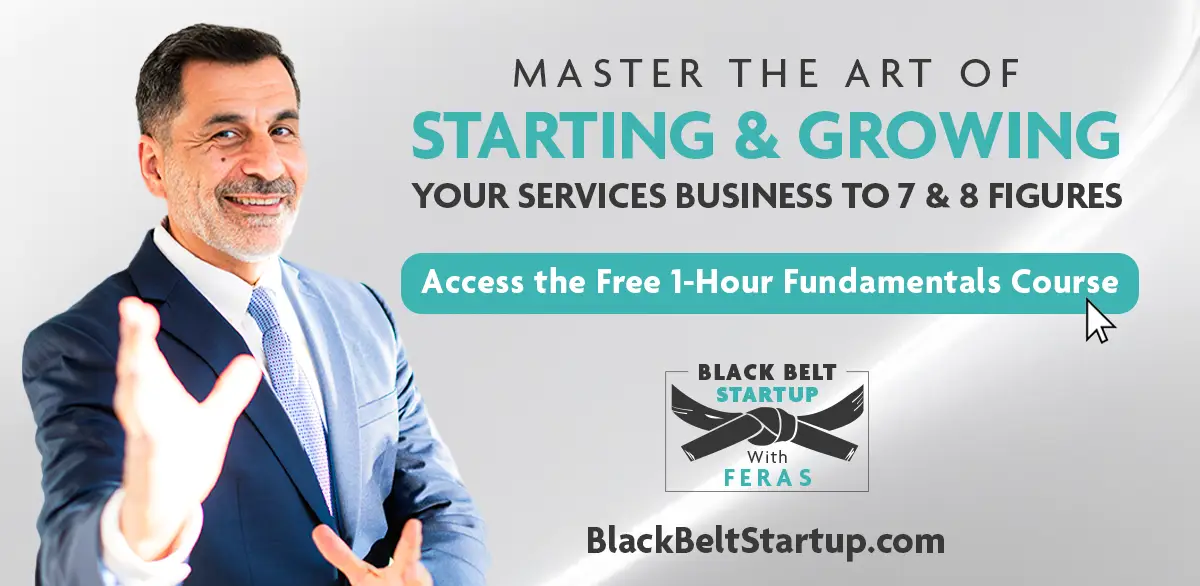How to Master the Consulting Sales Process: A Step-By-Step Guide for Success

“Good sales people are not born; they are trained.”
– Dave Kurlan, Sales Trainer, Author, and Speaker
When I started my first consulting firm, I thought there was no way I could master the consulting sales process. I never thought of myself as a salesman. I just expected it to always be a struggle to persuade prospects. I was wrong.
I began my career as an engineer. I loved math and solving complex problems. But I didn’t think I could excel at something as people-oriented as sales. I thought those who did sales were gifted.
While it’s true that some people have personalities more attuned to pitching, connecting, and storytelling, the good news is you don’t have to be born that way.
I learned there’s a process to sales – this stuff has a science to it that anyone can learn, whether you’re selling consulting services or some other type of service.
Importance of a Well-Defined Sales Process in Consulting
What is a Sales Process?
Before we get into it, let’s answer a simple question: What is a sales process?
The sales process is a systematic approach that businesses use to convert prospects into customers. It typically involves several stages, each designed to move the potential client closer to making a purchase.
It’s not unlike following a cake recipe. You have your ingredients and the steps needed, and as long as you follow the recipe, the results should be the same. At its essence, any process is like a recipe.
I first learned this idea from an old set of Tom Hopkins Real Estate Sales CDs that a friend loaned me. I wasn’t selling real estate, but the information was just as helpful (plus, money was tight, and I didn’t want to spring for another set of CDs).
Learning there was a step-by-step approach to sales eased my fears and helped me succeed in business.
Now it’s time to outline the sales recipe.
What Are Common Sales Principles in the Consulting Sales Process?
While the specific sales steps for your service and company might be different from others services and other companies, the overall approach to sales is more common than we may realize.
Think about it this way. You have to find leads (i.e. people) interested in what you offer. Then, as you build your lead database, you will want to ensure that each lead is qualified and a good fit for your business.
Throughout this sales process of finding and qualifying leads, you’re engaging with them, building rapport, getting a thorough understanding of their needs, and educating them about the value of your services. To do this, you might deliver a formal presentation, run a demo, or share a success story. These tactics help to solidify your position as the service provider of choice.
Now even if if you’ve completed the above steps flawlessly, clients will have objections. They might want the service done faster or cheaper or both. Effectively addressing any objections and easing any doubts the prospect has will get you closer to a signed contract.
Sales Process vs. Sales Funnel
The terms “sales process” and “sales funnel” are often confused, with some believing them to be the same thing. While there are similarities, they represent different concepts.
- Sales process is the series of steps or actions you or your sales team follows to capture, nurture, and convert leads into sales.
- Sales funnel is the same process as viewed from the lead’s perspective – it’s their journey through the process from the initial awareness to buying from you.
It’s a matter of perspective – internal or external. When working on improving the process, it’s good to keep in mind which perspective you’re viewing it from.
Now let’s tackle the sales process, one step at a time.
Consulting Sales Process: Understanding the Prospect’s Needs and Digging Deep
To accomplish the first step of the consulting sales process, you must first understand the lead’s needs. This discovery process is the input into the system. When you go to the doctor with an issue, she asks about medical and family history, your symptoms, when the symptoms started, etc. These questions help her determine the most likely culprit and develop a treatment plan.
It’s the same when talking to a prospect. You want to ask questions so you can identify the source of their symptoms and recommend a solution.
Identifying the Prospect’s Pain Points
As you gather information about the lead’s pain points, goals, and needs, sometimes you hit a barrier. The problem is, sometimes the lead doesn’t know what they need, and at other times, they think they need a solution the service won’t provide.
Questions To Ask a Lead at the Beginning of the Sales Process
To discover what your prospective client wants, ask questions to get to the core of what it is they want and the problem(s) they’re facing:
- Out of curiosity, why did you reach out for consultation?
- What specifically are you looking to get help with?
- What other solutions have you tried? (Example answers: doing it in-house, hiring a specialist, buying a software system, etc.)
- Have you worked with someone like us before? (If yes:) How did that work for you?
- Who will be involved in the purchasing decision?
- What does success look like if you worked with me/us?
- If we solved this problem, is there anything else that might prevent the success you are hoping for?
Never be afraid to ask questions. The more you ask and seek to understand their situation and goals, the more professionalism and competence you exude. Of course, you need to be tactful and build trust during the process.
Dealing With Resistance
Resistance at this point is normal.
When the prospect is resistant, sometimes it’s because they’re embarrassed about their situation. For example, if you’re an accountant, the prospect might be sheepish about admitting they’re a year behind on their bookkeeping.
But for some prospects, there could be a level of ignorance regarding what you do and how you do it. They might not understand all the ways you help or how you will work with them. Maybe they’ve never hired a consultant or service business like yours before. And they’re skeptical of what you’re offering. It’s up to you to establish trust, as discussed below.
Establishing Trust and Building Rapport
The foundation of sales technique is building a relationship – trust and rapport. Sales and networking expert Bob Burg said, “All things being equal… people will do business with, and refer business to, those people they know, like, and trust.”
All three are important. They must know, like, AND trust you.
How to Build Rapport
Connecting with a prospective client is not much different from connecting with anyone else. It’s a very human experience, no matter how cold some business people make it sound. While most business relationships don’t blossom into friendships, the working relationship requires the same basic elements of understanding and cooperation, which you can foster in the following ways.
- Tell stories: Share stories of other clients (or people you know of) who were in a similar situation.
- Preface questions by stating the reason behind them: Instead of asking, “How many employees do you have?”, you can more tactfully say, “To better propose a solution, I’m wondering around how many employees you currently have.”
- Empathize with them and their emotions, not their situation: It’s tempting to say, “I know exactly what you’re talking about,” but we never truly know. Instead, identify with their emotions: “That sounds frustrating,” “You must have felt confused,” or “It sounds like you were disappointed with the results.”
- Restate what they said: We build trust when we show we understand. If they explain that they are looking for someone to guide them through their first government bid process, you can restate what they said: “So what I’m hearing is this is your first time going through the bidding process, and you’re looking for someone to guide you through the Dos and Don’ts.”
When we can establish trust and rapport, prospects are more willing to be honest, and that honesty helps you to offer a better solution.
Additional tips for more effective client discussions with prospects:
- Analyze both spoken and unspoken cues.
- Take notes during your discussions.
- Review the notes.
- Follow up on any gaps.
Crafting a Personalized Solution
With the discovery process completed, it’s time to thoughtfully craft a solution for your prospect.
Apply your domain knowledge and expertise to propose the most suitable solution. Some providers are more than happy to sell a consulting solution for what the prospect asked for, even if it won’t solve the real problem.
As a service entrepreneur or consultant, you may have a few base packages to offer, but customize these as needed to avoid one-size-fits-all shortcuts that don’t really meet the client’s need.
Build a case in the proposal that maps your solution to their specific problems and the desired result.
Presenting a Clear Value Proposition
Throughout every interaction with potential clients, you need to show how your experience and expertise make you the perfect choice.
You may have heard of the term “Unique Value Proposition” or UVP. There’s a chance you’re talking to this prospect to begin with because the UVP in your marketing materials resonated with them enough for them to reach out. (For more on creating UVPs, see Pricing and UVP for Consulting and Service Businesses).
When tailoring a solution during the sales process, restate your UVP as it applies to that client.
Qualifying the Lead
Throughout this process of uncovering the lead’s pain points and matching your expertise and UVP to the solution, you’ve probably determined that:
- the prospect is a good match for your services
- they can afford your services
- they are ready to make a purchasing decision soon
Leads who meet these criteria are considered qualified.
If they’re not qualified, don’t have the budget, are just “kicking tires,” or are not an ideal fit, move on to the next one.
Once they’re qualified, the next step is to deliver a professional proposal.
Crafting a Persuasive Proposal
The key elements of a winning proposal include:
- A summary of the problem as the prospect described it and your proposed solution.
- A clearly defined scope of work, including what’s included and excluded and dependencies – especially dependencies that rely on the client or third parties.
- An outline of the timeline with specific milestones.
- Clear pricing and payment terms.
- All the legalese your attorney advised you to include such as terms and conditions or disclosure of typical agreements to be signed when the proposal is accepted.
Sending vs Presenting a Consulting Sales Proposal
There are several ways to present your proposal that can further feature the clients’ benefits and ROI in choosing you. For smaller businesses and consumers, a simple PDF/printed document or even PowerPoint-type slide deck will work fine.
If there are only one or two decision makers, you could present your proposal in person or on a video call. If real time isn’t an option, you can still make a proposal stand out in other ways. For example, I’ve received proposals that included a video walkthrough on a digital platform (such as Loom).
There’s no sure-fire approach in delivering a proposal. A video proposal could appear to have the wow factor, only to irritate a lead who doesn’t feel like watching a 10-minute video. Another prospect could feel a PDF was average, missing several key points. In the end, use your best judgment on a case-by-case basis.
Highlighting the Benefits and ROI of the Consulting Services
Regardless of which delivery method you choose, throughout the sales process you have (hopefully) focused on the benefits the prospect will get by working with you. Spell out these benefits in the proposal and give them a taste of what working with you looks like. A couple of items you could include:
- A mini-audit or a sample version of your service as a small investment to directly demonstrate expertise and value in parallel with the sales process
- A case study where you highlight your expertise in delivering a solution that is similar to what the client needs
The goal is to inspire the client and convince them that what you offer is going to benefit their business. They need to trust that you will help them get what they want.
Establishing Clear Expectations and Deliverables
There can be no doubt in the prospect’s mind about when you will start, what happens during the contract period, and the planned termination date.
Depending on your business, you might depend on the client or another third party in order to make delivery. These are dependencies. Ensure that each dependency is called out. There’s nothing worse than missing a milestone because a department head didn’t get you something in time and you made no exception for such a dependency.
Being thorough with the deliverables also shows your thoughtfulness and professionalism by helping the prospective client see exactly what they will handle and manage their expectations.
When setting expectations and deliverables, favor underpromising and then over-delivering.
Handling Objections and Closing the Sale
Handling Objections and Closing the Sale
Earlier, we looked at handling objections and concerns raised during the initial phases of sales. As you sell more, you will build a library of responses to almost every obstacle and address many of them before the lead raises them.
How long does your process take?
We don’t have a big budget.
The last company we hired didn’t deliver.
These are common examples of concern that a prospect raises. They tend to fall into the following categories:
- Money — Price is top of mind for many clients.
- Time — They might need something on a deadline and are concerned about your ability to deliver on time.
- Value — Can you deliver something that will solve their problem or be a waste of both time and money?
- Quality — Will you deliver a quick fix, or something that will stand the test of time?
Anticipate common objections and concerns and address them early and directly in the sales process. The sooner you can eliminate these doubts from the prospect’s mind, the more they likely are to listen to what you have to say.
Sometimes, however, obstacles and new questions arise after you deliver the proposal. This is a good thing – it means they want to do business with you but need to make sure there are no proverbial bumps in the road.
Addressing Any Concerns or Objections the Client May Have
Don’t brush off any concerns or objections the client has at this point. They need to be acknowledged and dealt with, even if the concern seems trivial from your perspective.
A flippant “You don’t need to worry about that” is a sure way to lose the deal.
Handle each concern with empathy and thoughtfulness. Repeat what they said to make sure you understand their exact issue. If you already addressed it in your proposal, don’t say, “As we mentioned on page 6.” Instead, simply address it as you did in the proposal.
Other times, they raise objections related to their uncertainty of what you will deliver. Here, you can use any client stories, case studies, or other third-party data to help build trust. Show savings, ROI, or testimonials of others benefitting in the same way they will if they go with you.
Concerns about pricing and terms mean they’re ready to close the deal as long as they feel like they’re getting a fair deal. We’ve entered the negotiation phase.
Negotiating Terms and Pricing
Negotiating pricing and terms is nothing to be feared. Both parties want to be treated fairly. Come well-prepared, knowing what you are flexible on and what they ultimately want. Own the value you deliver and always be willing to walk away from the deal – being bullied into pricing and terms you can’t really live with is no way to run a business (unless you’re very early-stage and just need to sell to get established). In my experience, an overwhelming majority of clients are fair-minded and easy to appease when you approach negotiations with flexibility and professionalism.
Additional services for the same price
Customers naturally aim to maximize the value of their investment and may ask for additional services at the same price. Consider providing supplementary, less demanding extras as an incentive for them to invest in the primary service.
These additional offerings might include:
- Help with technical aspects or product usage.
- Training sessions.
- An additional month of service.
- Free trial periods. (As per insights from Forbes, free trials serve as an effective sales tactic, effectively reducing the expense of acquiring new customers.)
Securing the Commitment and Closing the Sale
Once both parties have agreed on the price, service, and terms outlined in the proposal, it’s time to get the signature on the sales contract.
An additional challenge that may arise, particularly in B2B contexts, is legal involvement from the client’s side. This might delay the signing process, causing potential engagement with legal representation on your end. Be prepared for such occurrences.
Assuming legal processes are not a hindrance, your deal should be nearly completed.
However, refrain from premature celebration until you complete two more critical steps:
- Get a signed agreement.
- Secure payment at the earliest opportunity.
Remember the adage “time kills all deals.” People may change their minds, competitors might intensify their pitches, offering deeper discounts if they sense losing the deal to you, and various other factors could arise. The key is to act swiftly, secure a signed agreement, and promptly receive payment.
Post-Sale Follow-Up and Relationship Building
The sale is never the end. Once you enter the delivery phase, you, as the business owner and/or salesperson, should ensure that the client is satisfied with the service and foster future deals and opportunities.
Managing Client Expectations and Ensuring Satisfaction
After getting the contract signed, continue to build the relationship during and after the delivery phase. Do whatever it takes to deliver on the promises made about your consultative services, especially if you’re a new startup. Even in the digital age, most businesses thrive on reputation. You need to make sure you establish a reputation as a company that does what it says and makes good when things go wrong.
But just because you’re meeting your milestones and the client is silent doesn’t mean they’re happy. Despite your best efforts, misunderstandings can occur. Touch base with your client periodically outside of formal meetings – make sure they are satisfied with the delivery. If you promised A, B, and C, but they were also expecting to get D, this is an opportunity for them to bring it up person-to-person and have it addressed.
Maintaining a Personal Relationship With the Client
Over this time working through and beyond the sales process, you probably got to know their likes and interests. Note those in your CRM system, and when you come across articles, videos, books, or events that they might enjoy, pass them along. Keep the lines of communication open.
A CRM, or Client Relationship Management system can be as simple as a spreadsheet or as complex as an enterprise-level software system with multiple integrations. CRM platforms include Salesforce and HubSpot. There are a variety of digital solutions with low- or no-cost options that scale along with your needs. For more information on CRMs and how to use them, watch this video. Also see DIY CRM sheet and video.
Seeking Referrals, Testimonials, and Case Studies
Which leads us to this often-overlooked goldmine: getting referrals and testimonials. After completing a successful project or service delivery, consider leveraging your satisfied clients for testimonials and referrals.
Reach out to satisfied clients and ask if they’d be willing to provide a testimonial about their experience with your service. You can suggest featuring their testimonial on your website, social media platforms, or marketing materials.
Explore the possibility of developing a case study based on their positive experience, highlighting the challenges they faced and how your service provided a solution.
Encourage satisfied clients to refer others to your business. You can incentivize referrals by offering the referring client discounts or other benefits for successful referrals.
Let’s recap what we covered today.
Recap of the Key Steps in the Consulting Sales Process
- Prospecting: Identify potential customers or leads interested in your service.
- Qualification: Ensure leads are a good fit for your offering.
- Engagement: Build rapport, understand pain points, and educate prospects.
- Presentation: Highlight features, benefits, and value proposition.
- Objection handling: Address concerns effectively.
- Closing: Finalize the deal, sign contract, or agree on terms.
- Follow-up: Maintain responsiveness, ensure satisfaction, nurture for future opportunities.
Emphasizing the Importance of a Strategic and Client-Centric Approach
- Understand the Client’s Needs: Conduct a thorough discovery process.
- Identify pain points: Ask probing questions to uncover genuine needs.
- Conduct research and analysis: Fill in gaps, gather additional insights.
- Establish trust and Build rapport: Tell stories, empathize, restate concerns.
- Craft a custom, personalized solution: Tailor offerings to meet specific needs.
- Present a clear value proposition: Showcase expertise, address concerns.
Final Thoughts on the Impact of an Effective Sales Process on the Success of a Consulting Business
Marketing and awareness on their own are not enough to sell your services. No online presence, marketing funnel, or ad campaign will work in isolation. All require a sales process to move people from leads to clients.
Consulting businesses can maximize their success and foster long-term relationships by following a structured sales process and prioritizing client needs and satisfaction.
In the beginning, sales is like priming a water pump. Work hard at first to get the first trickle of clients, and only then, with good relationship-building skills, do sales become easier to close.
Sales isn’t a four-letter word to be feared. It’s a skill to be nurtured and developed so you build a successful business.




